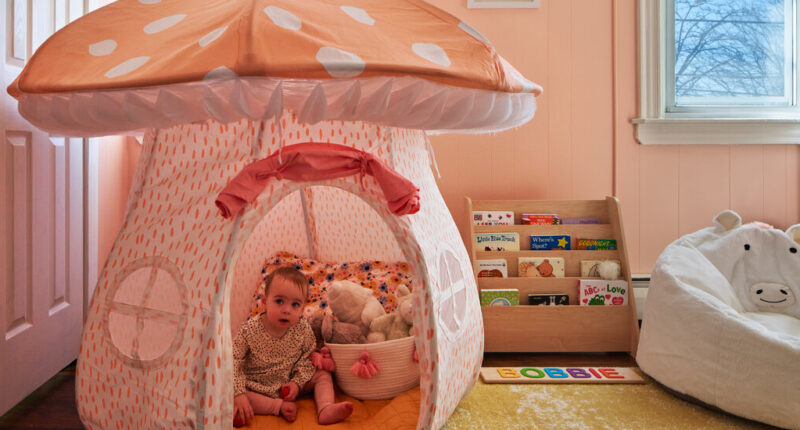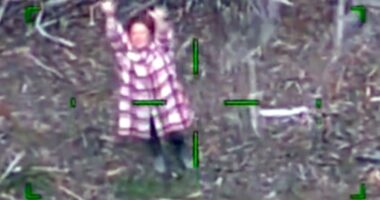
Jayna Roy wanted her newborn daughter to dream of mushrooms.
Since she couldn’t take her baby on foraging trips, she decided to do the next best thing: turn her nursery into a mushroom-themed, cottagecore haven. Ms. Roy designed the space to include over a dozen fungi-related items, among them crib sheets colored with mushroom dye, a felt mushroom mobile, a mushroom-shaped stained glass ornament and mushroom dresser knobs that she handmade herself.
“Mushrooms are so adaptive and diverse. They spark this sense of wonder in people, and I wanted to bring that into our home,” said Ms. Roy, 31, who runs a metal design business in Eddystone, Pa. “We’re so oversaturated with information all the time, and to be out in nature foraging for mushrooms, it gives you this sense of much-needed mystery, like you’re looking for a mythical creature.”
Mushrooms are becoming more prominent in nearly every aspect of modern life. Food, drink, fashion, medicine and interior design have all welcomed mushrooms lately — a trend which experts attribute to increased collective knowledge about mushrooms. Even negative portrayals of mushrooms in pop culture have at times piqued interest — like in the case of HBO’s “The Last of Us” series, in which a parasitic fungal infection turns people into zombies, but instead of avoiding them after watching the show, some fans were looking up the best mushroom snacks to make for viewing parties.
In recent years, the British clothing designer Stella McCartney debuted garments made of mushroom leather, grocery stores began stocking mushroom teas and elixirs, and psilocybin (or “magic mushroom”) therapy has taken off. Still, we can’t get enough of them. Not only do we want mushrooms to eat and drink and wear and heal, we also want mushrooms to sit on, sleep on and adorn our homes with. Put simply, there is currently demand for (and likely, supply of) mushroom-themed anything and everything.
Mushroom-inspired interior design objects range from high-end (artisanal lamps that sell for thousands) to widely accessible ($18 cocktail glasses that can be found on Amazon). The objects themselves can be fungi-related in a very literal sense, such as furniture made with mushroom leather, or more figuratively, borrowing abstract shapes or colors from the fungi.
There’s been a slew of books and other media released over the past few years that explore the many facets of mushrooms, converting more people into ’shroom swooners and mycophiles. Recent examples include the anthropologist Anna Tsing’s book “The Mushroom at the End of the World,” which uses matsutake mushrooms as a lens to analyze capitalism; the biologist Merlin Sheldrake’s New York Times best seller “Entangled Life”; Netflix’s “Fantastic Fungi” documentary, which helped to popularize the idea that primates could have evolved into humans with the help of psilocybin mushrooms (the “stoned ape theory”); the electronic musician Jon Hopkins’s album “Music For Psychedelic Therapy”; the late composer John Cage’s recently reissued book “A Mycological Foray,” which has become a coffee-table favorite; and a small magazine called Mushroom People.
“Mushrooms are having their moment across many layers of society,” said Paul Stamets, one of today’s most well-known mycologists, who recently had a new species of magic mushroom named after him. And perhaps, there’s something innately human that draws us to mushrooms, because of their integral role in ecosystems. “Mushrooms are sort of the interface between life and death, and their sudden appearance is surprising, mysterious, arouses curiosity and invites exploration,” Mr. Stamets said.
From Signs of Death to Symbols of Regeneration
On Etsy, searches for mushroom gifts have more than tripled in the last 12 months compared to the same time the previous year, according to data provided by the platform. In particular, mushroom vases, wallpaper, candles and tables have all seen a rise in search interest.
The Museum of Modern Art Design Store carries over a dozen mushroom-shaped lamps, which are some of its best-selling products, said Chay Costello, the associate director of merchandising.
One of the most iconic mushroom-resembling modern objets d’art is the Nesso lamp. Available in white or bright orange, the lamp looks like an ethereal, glowing mushroom. It was designed by Giancarlo Mattioli in 1964 and added to MoMA’s collection soon after, exemplifying “the era’s enthusiasm for space-age forms and materials,” Ms. Costello said.
“Overall, we are seeing a resurgence in interest in the designs of the 1960s and 1970s, driven perhaps by similarities in the zeitgeist of those decades and our own current era,” Ms. Costello said.
But our ancestors in the West might be confused by the current mushroom mania. In 17th-century England, it was the norm to fear mushrooms.
Because they were often found amid death and decay, mushrooms were closely associated with the end of life — and not in the “at peace with Mother Nature” way they might be today. They were often referred to as “excrements of the earth,” and fear of poisonous mushrooms was widespread.
There was a lack of scientific knowledge about mushrooms at the time, which meant they were a largely enigmatic entity with wide-ranging effects. “Some mushrooms can feed you, some can heal you, some can kill you and some can send you on a spiritual journey,” Mr. Stamets said. “To have something that’s so powerful and so ephemeral, it’s natural to fear the unknown.”
Americans held residual anxiety from those attitudes against mushrooms for years. As recently as 2014, mushroom farmers have spoken about the stigma they’ve had to overcome at American farmers’ markets.
But the past few years have indicated a major shift. In 2022, mushroom sales in the United States increased by 16 percent compared to 2013, according to data from the Mushroom Council, the fresh mushroom industry’s commodity board.
Recent legalization of psilocybin in the United States helped push fungi more into the cultural forefront. Oregon became the first state to allow psilocybin for therapeutic use in 2020. Last year, Colorado followed suit, legalizing personal use and growing for those over 21. While psilocybin remains illegal at the federal level, several cities — including Seattle, Ann Arbor, Mich., and Oakland, Calif. — have decriminalized it.
The influence of Asian culture has also played a major role in opening up the United States to mushrooms. In East Asian countries, including China and Japan, mushrooms have been regarded more highly, and are often viewed as symbols of rebirth and regeneration. The reishi mushroom, also referred to as the “mushroom of immortality,” was revered in East Asian culture for thousands of years for its health benefits. Now, one can order a reishi cappuccino at Erewhon, the trendy health food store in Los Angeles.
A Psychedelic Experience, Minus the Drugs
Suddenly, it’s as if Americans are making up for lost time with mushrooms.
It’s been well-documented that the pandemic lockdown turned more people on to interior design and the importance of the home as a space to reflect their tastes and desires. That, coupled with a growing love for mushrooms, has resulted in people stuffing kitchens, bedrooms, office rooms and even bathrooms with mushroom-inspired trinkets and furniture.
Arushi Kapoor, a 26-year-old art dealer, wanted one of the bathrooms in her Los Angeles home to showcase her love for fungi.
“We’re very pro psychedelic and non-psychedelic mushrooms. We love cooking with mushrooms, trying different kinds,” Ms. Kapoor said. “They have a mystical sense to them, but they’re also very grounding and earthy — they give us the best of both worlds.”
Ms. Kapoor’s bathroom has a Matthew Ryan Herget photograph of mushrooms hanging on the wall, a bong with a glass mushroom at the bottom, a mushroom cap-shaped lighting fixture by designer Tom Dixon which makes it look like fungi are coming out of the ceiling, a psychedelic light that projects dynamic colorful rays onto the walls and other small mushroom paraphernalia.
“The whole idea of the bathroom is to give you a psychedelic experience without actually inhaling any psychedelics,” Ms. Kapoor said.
Retailers and brands have taken note of the growing obsession, too.
In 2021, the millennial beauty brand Glossier opened a store in Seattle that had, as its centerpiece, an Instagram-friendly, mossy sculpture with colorful mushrooms sprouting out of it. This winter, the Standard hotel in New York’s East Village opened a trippy outdoor dining garden with oversized mushroom sculptures (the prix fixe dinner menu has some fungi options, including a mushroom ragù lasagna and mushroom chili Frito pie).
For those making the mushroom goods, part of the appeal is that the common mushroom form we all know — the pillar with a soft-edged cap — lends itself to versatile designs. It’s simple, yet iconic.
When Tessa Gourin, 28, an actress in Manhattan, spent her stimulus check on ceramics classes, she found that mushrooms were an easy shape to imitate. She made mushroom-shaped candlestick holders, which were eventually picked up by Coming Soon, a home goods store on the Lower East Side.
In 2017, Nicholas Bijan Pourfard, who just started out as a furniture designer, began making hand-thrown mushroom-shaped lamps with a ball-joint design that allows people to tilt the shade and direct light however they wish. He’s since sold hundreds of the lamps, and the luxury e-commerce site Ssense now carries them. “It wasn’t my first intention when the pen hit the paper to make a mushroom lamp, but once I realized that’s what it was beginning to look like, my brain kept going even more towards that form and shape,” said Mr. Pourfard, 31, who is based in San Diego.
Evan Collins, co-founder of the Consumer Aesthetics Research Institute, posits that the boom of mushroom décor is a counter to the minimalism that dominated the 2010s. “There’s a renewed interest in the really playful, the surreal, the weird; whereas in the 2010s, it was all about being restrained and calm, like millennial pink,” Mr. Collins said.
The Future Is Fungi
Mushrooms also represent the possibility of a more sustainable future.
MoMA has a mycelium brick in its collection, for which the description reads, “When used as building blocks, the resulting mycelium bricks create a structure that temporarily diverts the natural carbon cycle to produce architecture that grows out of nothing but earth and returns to nothing but earth — with no waste, no energy, and no carbon emission.” (Similar to plant roots, mycelium is the weblike structure of filaments that nourishes fungi, typically underground.)
Last year, the furniture retailer Ligne Roset announced a partnership with the biotechnology company MycoWorks to release a line of mycelium-derived furnishings.
Researchers at Pennsylvania State University have been working on pioneering a material called “MycoKnit” for architectural structures. The material has a knitted textile base, from which a mycelium composite grows atop. MycoKnit is, in a very real sense, living — in time, visible mushrooms will eventually sprout from it.
The research team — which includes Felecia Davis, Benay Gursoy, Ali Ghazvinian, Farzaneh Oghazian, John Pecchia and Andre West — is currently working on constructing a full-scale pavilion using MycoKnit in Melbourne this summer.
Ms. Davis, an associate professor of architecture, said that she hopes this research can help people better understand interspecies relationships. “We live with this species that has its own life, that we are using to design with to make buildings and things,” she said. “Who is this that we are building with? How might we reconsider mycelium?”
Source: | This article originally belongs to Nytimes.com









